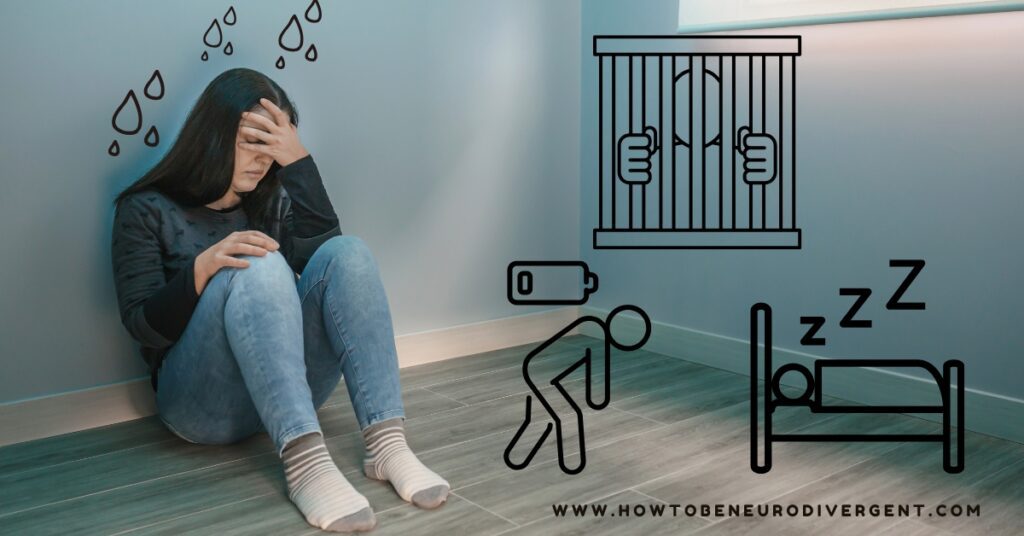Table of Contents
ToggleAlways Feeling Tense and Jittery?
If you’re part of the late-diagnosed autistic and ADHD community, you are probably very familiar with the feeling of being “always on edge” or constantly exhausted. Knowing you have a different neurotype than the majority of people around you can feel like a complete revelation. You haven’t been imagining it or spinning up thoughts that cause tension that isn’t real. It is very real. And understanding how to apply nervous system regulation to your unique mind and body changes everything.
Nervous System Basics (Simplified)
Let’s Talk About the Autonomic Nervous System.
The autonomic nervous system (ANS) controls involuntary bodily functions like heart rate, blood pressure, and digestion. This system is made up of two main parts that work together to keep us feeling balanced and regulated.
One part, the sympathetic nervous system, prepares the body for impending stress. This is the part responsible for the “flight or fight” reaction.
Another part, the parasympathetic nervous system, manages what we call the “rest and digest” functions. This is responsible for calming the body down and conserving energy.

Polyvagal Theory
The Polyvagal Theory, developed by Dr. Stephen Porges, gives us a framework for understanding how our nervous system responds to different situations. There are three main responses the nervous system can have.
The first is the “fight or flight” response or “mobilization”. This response is activated when we sense danger or threat. It prepares our body to either fight for your life or run for your life.
The second is the “collapse”/“shut down” or “immobilization response. This response is activated when we feel overwhelmed or completely helpless.
The third is the “social engagement” or “ventral vagal” response. This response happens when we feel regulated, relaxed, and open.
Polyvagal Theory explains that these nervous system responses are all managed by the vagus nerve, which runs through the body from the brain to the gut. You cannot live without a properly functioning vagus nerve. This is important insight to have because we can learn techniques to stimulate the vagus nerve in order to calm the body’s stress response. More research is being done on the potential benefits of vagus nerve stimulation and the health conditions it has the potential to improve.

What is the Window of Tolerance?
The Window of Tolerance is a psychological concept. It is the window in which we have the capacity to stay regulated, present, and clear-headed. It describes the capacity we have to manage ourselves in the moment. It is when we are functioning at our best and not being pushed into “fight or flight” or “shut down,” regardless of the situation.
This is important to know as a person with a neurodivergent nervous system. People with an autistic or ADHD neurotype generally have a narrower Window of Tolerance. This means that our nervous systems react more sensitively and are more easily triggered than the nervous systems of people who are neurotypical.
Why is Regulation Harder for Autistic and ADHD Nervous Systems?
Things like sensory input, unexpected changes, and social misunderstanding can send our nervous systems into overdrive. On top of this, our nervous systems are less flexible. This means that it’s also more difficult for us to return to a regulated base-line.
Interoceptive challenges (difficulty reading your own body’s signals) can also add an extra layer of complexity. How can you maintain a regulated nervous system if you don’t recognize your body becoming dysregulated until it’s almost “too late.” Having “big emotions” and difficulty keeping our emotional responses at an “appropriate” level also adds a layer of complication.
These types of situations contribute to the feeling of being “an alien” in a world that wasn’t designed for us. It’s like everything in our environment is either too much or not enough. It’s like we’re on another planet with less oxygen, more gravity, and an uninhabitable temperature. But everyone around us was born with the adaptive equipment to manage and we weren’t.
It’s no wonder that regulation is more difficult. All of these factors (and more!) accumulate over the course of a day, a week, a month. Small stressors build on each other and compound into a situation that is too much for our nervous systems to handle.

The Late-Identification Factor
Decades without understanding our own nervous system needs often leads to chronic dysregulation. We may have found ourselves asking, “Why am I so anxious?” “Why do I feel irritable all the time?” “Why don’t I ever feel present?” “Why am I completely exhausted no matter what I do?”
Without realizing we are “built different,” we may feel confused and blame all kinds of things for our dysregulation that just aren’t accurate. We may follow well-meaning advice from others that actually increases dysregulation and makes things worse.
This eventually might even lead to masking our distress because we feel like nothing helps and no one understands our experiences. Instead of regulating ourselves, we suppress and internalize the stress over and over again.
This can have negative long-term effects. Having a nervous system that is constantly dysregulated can push us into periods of burnout, cause trauma responses in our mind and body, and lead to chronic exhaustion and chronic pain conditions.

Recognizing Your Dysregulation Patterns
If we have the self-awareness and knowledge to understand that we are biologically more easily activated, we can learn to manage and accommodate our nervous systems.
Recognizing the signs of various nervous system responses is a good first step in self-awareness.
Common Signs of sympathetic activation, “fight or flight”
- Irritability
- Anxiety
- Racing thoughts
- Restlessness
- Elevated heart rate
- Increased sweating
- Muscle tension
- Trembling
- Dizziness
- Confusion
Common Signs of dorsal vagal shutdown, “freeze” or “collapse”
- Numbness
- Dissociation
- Exhaustion
- Hopelessness
- Withdrawal
- Losing access to speech
- Zoning out
- Feeling like it’s impossible to move
- Headaches
Once you become more aware of the signs of nervous system activation or shutdown, you can learn to recognize what types of situations are personal triggers for you. This can help you know what to avoid and how to use strategies to regulate your nervous system before negative reactions intensify.

Building Your Personal Regulation Toolkit
It will likely take some trial and error to find regulation strategies that work for you. Every person responds differently. What works for one person may not work for you, and that’s o.k.!
Learn and experiment with some common regulation methods like:
- Gentle exercises
- Breathing techniques
- Sensory accommodations
- Focusing on an interest or hobby
- Resting
- Connecting with community or pets
Once you experience some success, it may be helpful to create a regulation menu for different situations to remind you of what works. You can include strategies that are regular preventative practices and strategies to regulate in the heat of the moment.
Unlearning and Relearning
After a life-time of trying to “white-knuckle” your way through life, there is a lot to unlearn. We may have to adjust our expectations and release the messages of toxic productivity and hustle culture. It’s going to take a major shift to challenge your impulse to “just push through it.”
It is critical to accept that we may need more downtime than others. Our regulation needs are valid. We must learn to set boundaries to protect our nervous systems and find our new “normal.” We need to work to find a balance between challenging ourselves and honoring our limits. If we don’t, the negative effects of chronic dysregulation can have significant long-term consequences.

Self-Compassion
Now that you can look back on your life through the lens of neurodivergence as a late-identified adult, it’s common to feel grief. You may feel grief over what you didn’t know before. It’s grief about continually pushing yourself so far beyond your natural capacity that your nervous system reacted in extreme ways, limiting your capacity even further.
In trying and pushing to do more and be more and become an “acceptable” human, you caused more dysregulation that had real tangible consequences for the quality of your life. You may have caused permanent damage to relationships, work opportunities, even your own health and body. And you can’t go back. There’s no do over.
You can now see, in hindsight, what you didn’t see before. And because science is only recently starting to recognize our experience for what it is, there likely wouldn’t have been any way that you possibly could have seen it. This fact alone gives us room for so much self-compassion. You didn’t know. You couldn’t have known. You did the best you could with the knowledge you had. Allow yourself grace and forgiveness.
The good news is, you know now. You are learning to speak the language of your nervous system. You are learning that you do have different needs than many people around you. You can and should take steps to care for those needs and support your nervous system through regulation practices.
Regulation is a practice and progress isn’t linear. But real progress and real change can happen for you. You can improve your quality of life moving forward.
Conclusion
It is never too late to learn new skills to improve your life. Regulation can be learned and improved at any age. Small changes, compounded over time, can lead to big changes for your future. Have hope and be encouraged for the journey ahead of you. You can start now. You deserve to feel safe in your body. Pay attention to one regulation cue this week. You can do it! Learn to support yourself one step at a time.
If you enjoyed this post, you might also like 👉 Understanding Stimming: Why it’s Important and How to Embrace it.
Thanks for listening, friends.

If you liked this article, you may also like:
My Nervous System Regulation Map (70-page PDF Guide + Workbook)
Designed for late-identified autistic and ADHD adults, My Nervous System Regulation Map is a practical, neurodivergent-friendly guide to understanding, mapping, and supporting your nervous system. This 70-page digital resource combines education with hands-on workbook exercises to help you build a personalized regulation toolkit that truly works for your unique brain and body.
BUY NOW for $15.00

Disclaimer:
This post reflects my personal experiences and perspectives as a late-identified neurodivergent adult. While I aim to share helpful insights, I don’t speak on behalf of the entire ADHD or autistic community. Neurodivergence is diverse and individual—please interpret this content through the lens of your own needs and experiences. This article is not a substitute for professional or medical advice.

